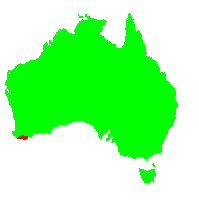General Description:
Banksia quercifolia is usually a rounded shrub up to 3 metres high by about 2 metres across. The leaves are up to 150 mm long and 30 mm wide and are of an elongated wedge shape with very serrated edges. The cylindrical flower spikes are about 100 mm long by 60 mm wide, greyish in bud and opening to a rusty brown. They tend to occur within the shrub and may be partially hidden by foliage. Like all banksias, the flowers are attractive to honey-eating birds. Flowering occurs from late autumn to early spring.
This species does not develop a lignotuber and is killed by fire. It relies on seed for regeneration.
B.quercifolia is suited to areas with a dry summer climate but is not widely cultivated. As it occurs in seasonally wet soils it may be more tolerant of poorly drained soils than many other banksias but is unlikely to survive in permanently wet conditions. In common with many other western banksias, it is difficult to maintain in areas of high summer humidity such as coastal areas of New South Wales and Queensland. It should be planted in full sun or partial shade. It is is moderately frost hardy.
Propagation from seed is reliable without pre-treatment. Cuttings sometimes succeed but may not develop a strong root system.
* EPBC Act = Environment Protection and Biodiversity Conservation Act 1999
ROTAP = Rare or Threatened Australian Plants (Briggs and Leigh, 1988)
For further information refer the Australian Plants at Risk page

Banksia quercifolia
Photo: Kevin Thiele – Australian National Botanic Gardens

Banksia quercifolia flowers in bud
Photo: Matt Denton
 Australian Native Plants Society (Australia)
Australian Native Plants Society (Australia)













